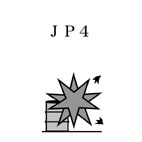| Case Name |
Fire and explosion at a jet fuel tank caused due to a thunderbolt from design error of an instrument device |
| Pictograph |

|
| Date |
July 1, 1987 |
| Place |
Chitose, Hokkaido, Japan |
| Location |
Self-Defense Force Base |
| Overview |
A thunderbolt struck a jet fuel tank (soil-covering 27 m in diameter, 6.1 m in height) at Chitose air force base. The tank exploded, and was destroyed by fire. The fire burned for about three hours. The thunderbolt struck a level gauge, which had resistance. It discharged in the tank, and combustible gas-air mixture in the upper part of the tank was ignited. |
| Incident |
A soil-covering fuel tank at a Self-Defense Forces base exploded at falling of a thunderbolt and caught fire. Refer to Fig2. |
| Processing |
Storage |
| Substance |
JP4 |
| Type of Accident |
Explosion, Fire |
| Sequence |
A 3260 kL capacity soil-covering tank was full of jet fuel. It exploded when a thunderbolt struck the tank during a thunderstorm. The tank collapsed, and the contents were burned down. The fire was extinguished after about 3 hours. |
| Cause |
Direct cause was the falling of a thunderbolt. A thunderbolt struck the conduit pipe of a level gage protruding from the roof or the level gauge itself. It discharged in the tank, combustible vapor in the tank ignited, and the tank exploded. Although lightning rods were installed in the tank, they did not function properly.
Although the tank itself was covered with soil, there were four projections from the roof connected directly to the tank's main body. One of the four projections was the measuring tape of the level gauge, and it had traces of electrical discharge. It is assumed that an electrical discharge occurred there. The other three projections were welded directly to the tank's main body, and did not have traces of electrical resistance or discharge. |
| Countermeasures |
1. Electric devices such as level gauges should be designed not to discharge.
2. The tank should be constructed as combustible vapor would not be generated in the upper part of it.
3. Not only specialists of one field, but also specialists of various fields should cooperate with each other in designing machinery or devices. |
| Knowledge Comment |
This accident was caused due to disregard of conductivity. Only instrument accuracy was regarded as important. Machines and instruments are often required to have various functions. This accident shows that cooperation among various specialists is necessary. |
| Background |
The resistance value of the level gauge was designed at main body to be 10 Ω or less that was equal to the lightning rod. However, bellows made of rubber were partially used, increasing resistance, and a high voltage was generated there. This seems to be a design error. The parts used for reducing measurement errors at the level gauge, became the resistance. The design should be examined from the viewpoint of both accuracy and safety. |
| Sequel |
After this accident, investigations of similar tanks were carried out at military bases in Kagamihara and Gifu by NRIFD. |
| Incidental Discussion |
Accidents with a soil-covering tank happened twice at Hyakuri base and Chitose base. Although soil-covering tanks were made for defensive reasons, they were considered to be safe for disaster prevention. However, a series of fires and explosions proved that soil-covering tanks are not always safe The fire at Hyakuri base was also caused by a thunderbolt. However, we have not heard of similar examples of fires in Japan after that.
Although the accident occurred in a soil-covering tank, it seems to be more desirable than an above-ground tank from the viewpoint of preventing disasters. |
| Reason for Adding to DB |
Example of fire caused due to falling of a thunderbolt at a soil-covering fuel tank |
| Scenario |
| Primary Scenario
|
Poor Value Perception, Poor Safety Awareness, Convince as Safe, Planning and Design, Poor Planning, Poor measure against thunderbplt, Secondary Damage, External Damage, Explosion, Bodily Harm, Injury, 1 person injured
|
|
| Sources |
Kazutoshi Hasegawa, Three examples of fire and explosion at petroleum storage tanks in 1987. The Japan Soc. for Safety Engineering edition, pp.138-146 (2002)
Japan Assoc. of Fire Science and Engineering, Disaster case. Tank fire. No.10 tank fire. , p.36 (1990).
|
| Number of Injuries |
1 |
| Physical Damage |
The roof of a tank and soil on it fell into the tank of jet fuel. Most of the tank props buckled. |
| Multimedia Files |
Fig2.Outlook of the soil-covering tank
|
| Field |
Chemicals and Plants
|
| Author |
KOSEKI, Hirosi (National Research Institute of Fire and Disaster)
TAMURA, Masamitsu (Center for Risk Management and Safety Sciences, Yokohama National University)
|